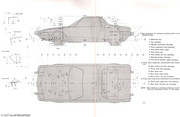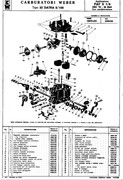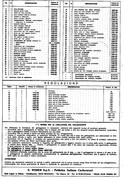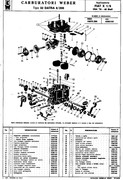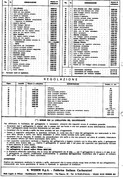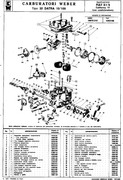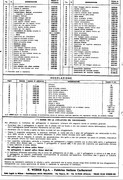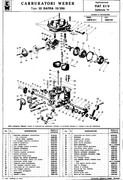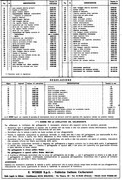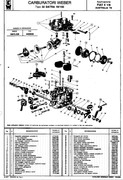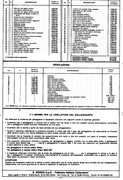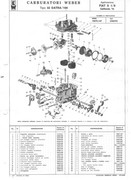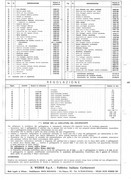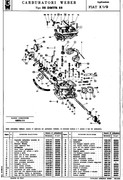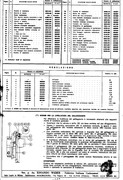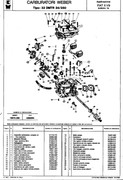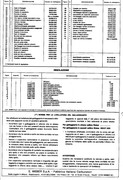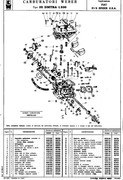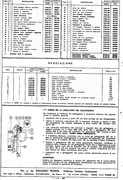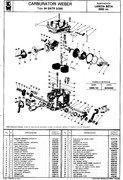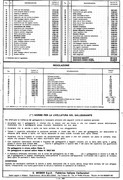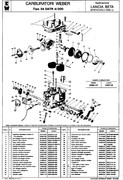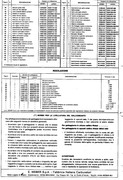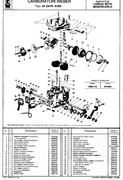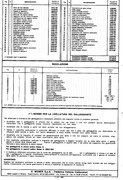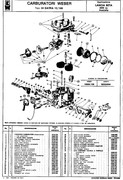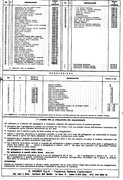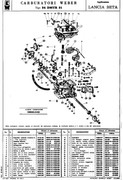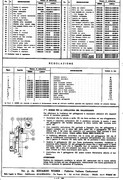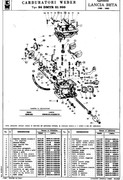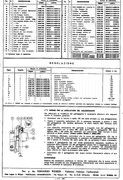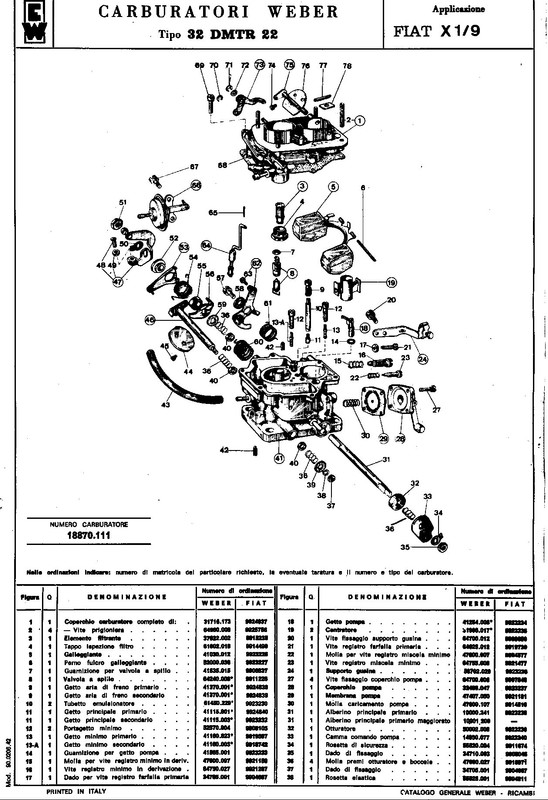fiatfactory
Steve Cecchele
Factory Engine Specifications
Below are some engine specification and output figures for the SOHC engine. I'll try and compile this in a more tabular format, but for now this will do. I have an extensive library of OE "Specifications and Features" which I'll scan a few pages and include thumbs next to each, as time permits
128 sedan
128 sedan 1100 1969 type128A.000
8.8:1 C/R
output 55hp * 6000 (din)
torque 7.9mkg*3600 (din)
12/52 52/12 camshaft
single choke 32ICEV weber
(source "Specifications and features" 128 sedan july 1969 Fiat)
I know all sedans have a single front exhaust pipe including the rally.The exception to this is 1974-only USA 128 1300 (Sedan, Wagon & Coupe) models all had a factory-supplied 4-into-2 cast iron exhaust manifold & corresponding 2-into-1 downpipe fitted to them.
128 sedan 1972 (usa specification) engine type 128A.040
8.5:1 C/R
output 52hp *6000 (din)
torque 7.5mkg*3400 (din)
10/54 54/10 camshaft
single weber 32ICA
(source "specifications and features" 128 sedan supplement USA 3/72)
128 sedan 1975 (european specification)
engine type 128A.000 (1100) / type 128A1.000 (1300)
both engines 9.2:1 C/R
output 55hp/60hp (din)
12/52 52/12 (1100cc) 20/44 60/4 (1300cc)
both engines single 32ICEV
(source "owners handbook" 128 sedan/wagon 1975 1st edition)
128 Sedan 1300 1976 (north american specification) type 128A1.040.6
weber 32DATRA11/100 carb, non catalytic
(source "specifications and features" supplement emissions USA 6/76)
128 sedan 1300 1976 (north american specification) type 128A1.031.6
weber 32DATRA14/100, catalytic converter
(source "specifications and features" supplement emissions USA 6/76)
128 Rally 1300 1971 type128AR.000
8.9:1C/R
67hp * 6200 (din)
twin choke carb 32DMTR 20
Single outlet exhaust manifold
(source "Caratteristiche E Dati" Fiat 128 Rally 1/1972)
128 coupe
128 coupe 1100 1971 type 128AC5.000
8.9:1 C/R
output 64hp * 6600 (din)
8.3mkg*3800 (din)
twin choke carb
(source "All the Fiats 1984")
from my other info, twin front downpipe, 24/68 64/28 cam
128 coupe 1300 1972 type 128AC.000
8.9:1 75hp (din) *6000
9.4mkg*3600
24/68 64/28 camshaft
twin venturi weber 32DMTR 20
(source "specifications and features" 128 sport coupe 1st revision 11/72)
128 coupe 1300 1972 U.S.A. version type 128A1.040
8.5:1 C/R
output 51hp*5600 (sae)
torque 8.5mkg *3000 (sae)
10/54 54/10 camshaft, single weber 32ICA
(source "specifications and features" 128 sport coupe 1st revision 11/72 U.S.A supplement)(dont ask me why some figures are quoted as S.A.E. because I dont know, it could just be for the US market, maybe that is the standard there?)
128 3P
128 coupe 3P 1100 1975 type 128AC5.000 (?)
9.2:1 C/R
output 65hp (din) (up 1 hp fron prev)
torque 8.9mkg*4100 (din)(up from 8.3mkg * 3800)
twin choke carb
(source "All the Fiats1984")
128 coupe 3P 1300 1975 type 128AC.000
9.2:1 C/R
output 73hp (din) (down 2hp from 75)
torque 10.2mkg*3900 (din)(up from 9.4mkg*3600)
twin venturi weber 32DMTR/??
(source "All the Fiats 1984")
128 coupe 3P 1300 1978 (aust specification) type128AC.023
9.2:1C/R
12/52 52/12 camshaft
32DMTR/32 carb, has emmision control gear on it (fuel vapour recirculation)
the inlet manifold has much smaller inlet ports, it quotes 73hp (din) (but I dont think so...like the inlet manifolds supplied to USA 3P's)
(source "owners handbook" 128 3P )
128 3P (North American version)
type 128A1.040.5 non catalytic (1975)
type 128A1.040.6 non catalytic (1976)
type 128A1.031.6 catalytic (1976)
8.5:1 C/R
output 62hp *6000 (sae)
torque 9.3mkg*4000 (sae)
10/54 54/10 camshaft
twin choke weber 32DATRA1/100 non catalyst ' 75
twin choke weber 32DATRA11/100 non catalyst ' 76
twin choke weber 32 DATRA14/100 catalyst ' 76
(source "owners handbook" 128 3P US version 1976)
X19's
X19 1300 1972 type 128AS.000
8.9:1 C/R
75hp * 6000 (din)
(source "All the Fiats 1984")
from my info, twin choke carb, twin front pipe,24/68 64/28 cam in europe
X19 1300 1977 (australian specifications) type 128AS.023
9.2:1 C/R
12/52 52 12 camshaft
5 degrees static ignition and 28 degrees + - 2 of centrifugal
single front pipe, no catalytic, but the system as per catalytic with just a test pipe fitted, weber 32 DATRA 19/100
(source "owner handbook" X19 9/77 3rd edition)
I can confirm all of this too, as i've dialed the standard camshafts, and cc'ed the standard chambers, standard output unknown, quoted as 73hp (din) (din_think_so :shock: )
X19 1300 (usa specifications) type 128AS.031.5 non catalytic
type 128AS.031.6 catalytic
8.5:1 C/R
output 61.5hp *5800 (sae) (C.C. cars 61hp)
torque 9.3mkg*4000 (sae)
10/54 54/10 camshaft
32DATRA (various) carburettor
(source 'specifications and features" X19 (us model) 1977)
X19 1978 (five speed) type 138AS.000
9.2:1
output 85hp (din)
torque 12mkg*3200 (din)
twin choke carb (listed as 34DATR 7/250)
(source "All the Fiats 1984")
these definitely have the twin front downpipe, non catalytic, camshaft is 24/68 64/28 in europe)
X19 1981 (US specifications) type 138BS.031
8.5:1 C/R
output 75hp *5500 (sae)
torque 79.6ft/lbs *3000 (sae)
bosch L jetronic, catalytic convertor
(source "specifications and features" X19 supplement fuel injection 10/81)
X19 1982 (carburettor) 1500 (australian specification) type 138AS.023
9.2:1 C/R
output 80hp*5750 (din)
torque 12kgm*3250 (din)
10/54 54/10 camshaft
twin choke carb 32DATRA 23
(source "owners handbook" X19 Five speed 1980 1st edition, supplied with my 1500 5 speed X19, and once again I can confirm all this as I have verified the original cam specs)
Ritmo/Strada
Ritmo / Strada
60hp / 65hp / 70hp
1116 / 1301 / 1498
9.2:1 / 9.1:1 / 9.1:1
8.3mkg*3500/10mkg*3500/12mkg*3000
these use single choke carburettors 32ICEV 1100/1300 34ICEV 1500
(source "All the Fiats 1984")
Below are some engine specification and output figures for the SOHC engine. I'll try and compile this in a more tabular format, but for now this will do. I have an extensive library of OE "Specifications and Features" which I'll scan a few pages and include thumbs next to each, as time permits
128 sedan
128 sedan 1100 1969 type128A.000
8.8:1 C/R
output 55hp * 6000 (din)
torque 7.9mkg*3600 (din)
12/52 52/12 camshaft
single choke 32ICEV weber
(source "Specifications and features" 128 sedan july 1969 Fiat)
I know all sedans have a single front exhaust pipe including the rally.The exception to this is 1974-only USA 128 1300 (Sedan, Wagon & Coupe) models all had a factory-supplied 4-into-2 cast iron exhaust manifold & corresponding 2-into-1 downpipe fitted to them.
128 sedan 1972 (usa specification) engine type 128A.040
8.5:1 C/R
output 52hp *6000 (din)
torque 7.5mkg*3400 (din)
10/54 54/10 camshaft
single weber 32ICA
(source "specifications and features" 128 sedan supplement USA 3/72)
128 sedan 1975 (european specification)
engine type 128A.000 (1100) / type 128A1.000 (1300)
both engines 9.2:1 C/R
output 55hp/60hp (din)
12/52 52/12 (1100cc) 20/44 60/4 (1300cc)
both engines single 32ICEV
(source "owners handbook" 128 sedan/wagon 1975 1st edition)
128 Sedan 1300 1976 (north american specification) type 128A1.040.6
weber 32DATRA11/100 carb, non catalytic
(source "specifications and features" supplement emissions USA 6/76)
128 sedan 1300 1976 (north american specification) type 128A1.031.6
weber 32DATRA14/100, catalytic converter
(source "specifications and features" supplement emissions USA 6/76)
128 Rally 1300 1971 type128AR.000
8.9:1C/R
67hp * 6200 (din)
twin choke carb 32DMTR 20
Single outlet exhaust manifold
(source "Caratteristiche E Dati" Fiat 128 Rally 1/1972)
128 coupe
128 coupe 1100 1971 type 128AC5.000
8.9:1 C/R
output 64hp * 6600 (din)
8.3mkg*3800 (din)
twin choke carb
(source "All the Fiats 1984")
from my other info, twin front downpipe, 24/68 64/28 cam
128 coupe 1300 1972 type 128AC.000
8.9:1 75hp (din) *6000
9.4mkg*3600
24/68 64/28 camshaft
twin venturi weber 32DMTR 20
(source "specifications and features" 128 sport coupe 1st revision 11/72)
128 coupe 1300 1972 U.S.A. version type 128A1.040
8.5:1 C/R
output 51hp*5600 (sae)
torque 8.5mkg *3000 (sae)
10/54 54/10 camshaft, single weber 32ICA
(source "specifications and features" 128 sport coupe 1st revision 11/72 U.S.A supplement)(dont ask me why some figures are quoted as S.A.E. because I dont know, it could just be for the US market, maybe that is the standard there?)
128 3P
128 coupe 3P 1100 1975 type 128AC5.000 (?)
9.2:1 C/R
output 65hp (din) (up 1 hp fron prev)
torque 8.9mkg*4100 (din)(up from 8.3mkg * 3800)
twin choke carb
(source "All the Fiats1984")
128 coupe 3P 1300 1975 type 128AC.000
9.2:1 C/R
output 73hp (din) (down 2hp from 75)
torque 10.2mkg*3900 (din)(up from 9.4mkg*3600)
twin venturi weber 32DMTR/??
(source "All the Fiats 1984")
128 coupe 3P 1300 1978 (aust specification) type128AC.023
9.2:1C/R
12/52 52/12 camshaft
32DMTR/32 carb, has emmision control gear on it (fuel vapour recirculation)
the inlet manifold has much smaller inlet ports, it quotes 73hp (din) (but I dont think so...like the inlet manifolds supplied to USA 3P's)
(source "owners handbook" 128 3P )
128 3P (North American version)
type 128A1.040.5 non catalytic (1975)
type 128A1.040.6 non catalytic (1976)
type 128A1.031.6 catalytic (1976)
8.5:1 C/R
output 62hp *6000 (sae)
torque 9.3mkg*4000 (sae)
10/54 54/10 camshaft
twin choke weber 32DATRA1/100 non catalyst ' 75
twin choke weber 32DATRA11/100 non catalyst ' 76
twin choke weber 32 DATRA14/100 catalyst ' 76
(source "owners handbook" 128 3P US version 1976)
X19's
X19 1300 1972 type 128AS.000
8.9:1 C/R
75hp * 6000 (din)
(source "All the Fiats 1984")
from my info, twin choke carb, twin front pipe,24/68 64/28 cam in europe
X19 1300 1977 (australian specifications) type 128AS.023
9.2:1 C/R
12/52 52 12 camshaft
5 degrees static ignition and 28 degrees + - 2 of centrifugal
single front pipe, no catalytic, but the system as per catalytic with just a test pipe fitted, weber 32 DATRA 19/100
(source "owner handbook" X19 9/77 3rd edition)
I can confirm all of this too, as i've dialed the standard camshafts, and cc'ed the standard chambers, standard output unknown, quoted as 73hp (din) (din_think_so :shock: )
X19 1300 (usa specifications) type 128AS.031.5 non catalytic
type 128AS.031.6 catalytic
8.5:1 C/R
output 61.5hp *5800 (sae) (C.C. cars 61hp)
torque 9.3mkg*4000 (sae)
10/54 54/10 camshaft
32DATRA (various) carburettor
(source 'specifications and features" X19 (us model) 1977)
X19 1978 (five speed) type 138AS.000
9.2:1
output 85hp (din)
torque 12mkg*3200 (din)
twin choke carb (listed as 34DATR 7/250)
(source "All the Fiats 1984")
these definitely have the twin front downpipe, non catalytic, camshaft is 24/68 64/28 in europe)
X19 1981 (US specifications) type 138BS.031
8.5:1 C/R
output 75hp *5500 (sae)
torque 79.6ft/lbs *3000 (sae)
bosch L jetronic, catalytic convertor
(source "specifications and features" X19 supplement fuel injection 10/81)
X19 1982 (carburettor) 1500 (australian specification) type 138AS.023
9.2:1 C/R
output 80hp*5750 (din)
torque 12kgm*3250 (din)
10/54 54/10 camshaft
twin choke carb 32DATRA 23
(source "owners handbook" X19 Five speed 1980 1st edition, supplied with my 1500 5 speed X19, and once again I can confirm all this as I have verified the original cam specs)
Ritmo/Strada
Ritmo / Strada
60hp / 65hp / 70hp
1116 / 1301 / 1498
9.2:1 / 9.1:1 / 9.1:1
8.3mkg*3500/10mkg*3500/12mkg*3000
these use single choke carburettors 32ICEV 1100/1300 34ICEV 1500
(source "All the Fiats 1984")
Last edited:

